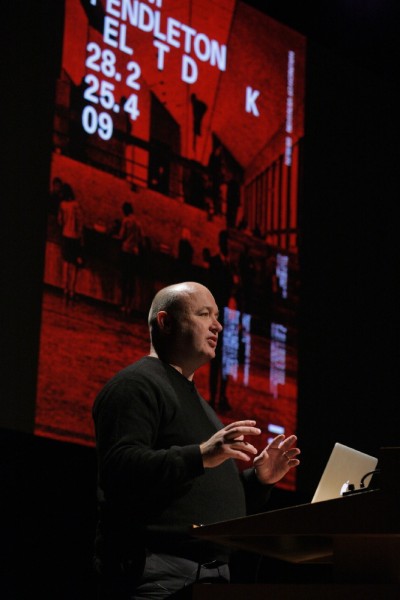Brook is also a warm and hugely likeable bloke whose own perspective on the conference theme involved taking us on a stroll through the Halifax of his youth, the record sleeves of his teens, and the efforts he went to in delivering an exhibition about Crouwel at London’s Design Museum. His demonstration of the essential difference between cricket chants from Lancashire and Yorkshire revealed much about his own innate desire to employ an economy of language and graphic ornament in his own work. His faltering on the mid-section of Philip Larkin’s famously brutal assessment of parents (at which point he was aided by a faultless prompt from Michael Bierut) did nothing to dim the passion of his reading or the poem’s meaning. Affectionate recollections of LP sleeves in his parents’ attic – from Little Richard to The Buzzcocks indicated the emergence – if not the actual ignition – of an early graphic instinct, and, inspiration from the typographic arrangements of Malcolm Garrett and Peter Saville.
But it was his reflections on stalking his hero that offered some interesting and applicable insights for those attending TYPO London.
Whether as speakers or as delegates, there are more than a handful of design heroes to be found at the conference – thanks in no small measure to the efforts of the organisers – in fact in this case even the organisers are design heroes. That being the case, some thoughts for attendees on the methodology and etiquette of stalking a design deity may not go amiss.
Such is the extent of Brook’s admiration for Crouwel and his work that he skillfully employed a number of cunning tactics in the pursuit of a more concrete relationship with his hero. As most designers, graphic or otherwise, have at least one living designer to whom they attest their skill, their philosophy, or even their career, it is worth picking some of the key methodologies employed in his ultimately successful Crouwellian odyssey.1. Baldness
Though not a generally desirable state of affairs, baldness certainly paid dividends for Brook in his quest. Crouwel is of course famed for his luxuriant head of hair, and many impressive photographs exist as proof of his follicular riches. Brook, it has to be said, is somewhat less well made in this regard, thus immediately putting Crouwel in a position wherein an implied virility and youthfulness would create the appropriate hierarchy of master and apprentice. As the degree to which Brook falls short in this area is immediately obvious (and is very much by his own admission), Crouwel would have been put at ease almost instantaneously.
2. Remember the home comforts
Long hours poring over the archive of a designer of Crouwel’s stature must surely have been demanding and tiring work. So, Brook made sure of at least some home comforts by insisting on taking delivery of one of only two examples of a New Alphabet rug known to be in existence. This not only provided him with a centrepiece for the Design Museum’s exhibition on Crouwel’s work (see point 3) but also doubled up as a handy and comfortable surface on which to take forty-winks during the exhibition’s final preparation stages.
3. Find a museum – any museum
It is very unlikely that in the event you do make contact with your design hero, they will take you seriously straightaway. Unless, that is, you have already spoken with a major institution about the possibility of a retrospective exhibition celebrating their life’s achievements. The benefits of this to anyone wishing to succeed as a design stalker are numerous, but chief among them is prolonged and intimate contact with a designers entire body of work, often but not always within a domestic setting. Therefore, having the details of a local, and ideally major museum with at least some semblance of a graphic leaning is crucial to success.

Tony Brook
4. Be ‘self-styled’
It is simply not good enough to be a stalker ‘in the mould’ of someone else. Should the topic ever arise in conversation with the object of your admiration, they will want to be reassured that you are pursuing them in a wholly original manner, rather than in a way that pays clumsy homage to other more widely known stalkers of the recent past. It is certainly possible to suggest that Brook’s ultimately successful stalking of Crouwel was in part due to the use and application of his own methods, not ones borrowed from others, thereby appealing to Crouwel’s own pioneering approach to graphic design.
5. Remember: it’s grim up wherever you are
Or rather, it’s not. It’s just the odd bit if weather. But certainly it’s important to understand and empathise with any geographic similarities you might share with your quarry. Brook, for example, hails from the north of Britain. The fact that Crouwel was also from the northern reaches of his own home country provided Brook with both topographic commonalities, and, a very useful ice-breaker for that tricky first conversation.
Text: Patrick Baglee











 Photo: Gerhard Kassner
Photo: Gerhard Kassner










